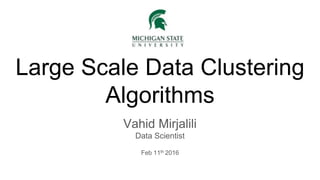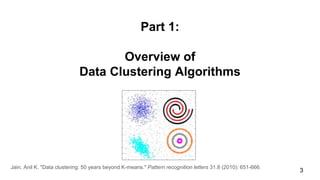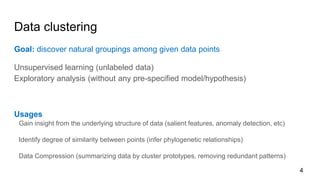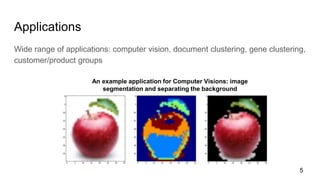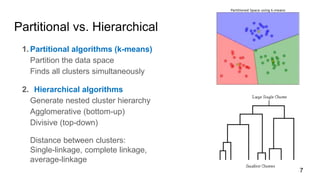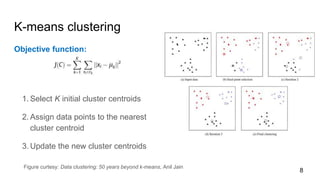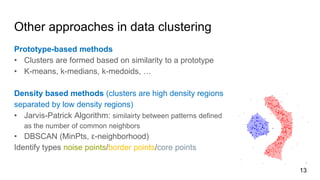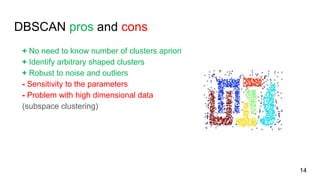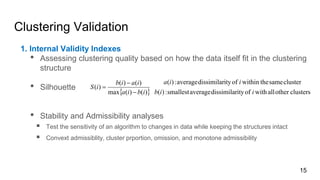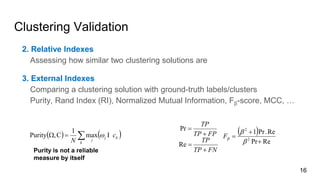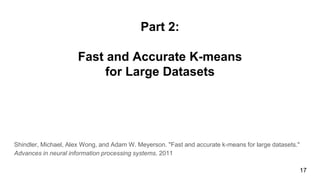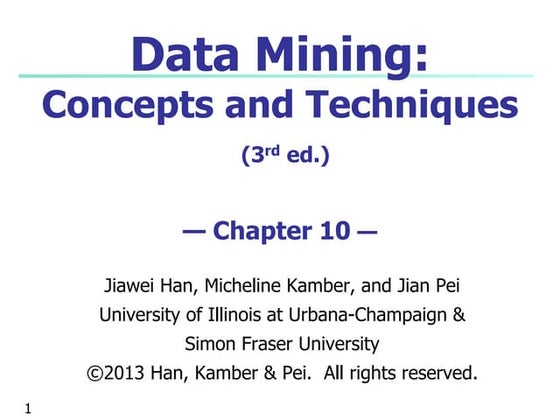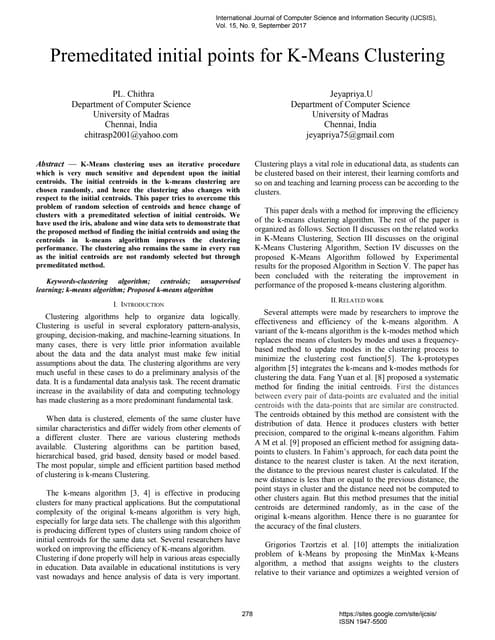Large Scale Data Clustering: an overview
- 1. Large Scale Data Clustering Algorithms Vahid Mirjalili Data Scientist Feb 11th 2016
- 2. Outline 1. Overview of clustering algorithms and validation 2. Fast and accurate k-means clustering for large datasets 3. Clustering based on landmark points 4. Spectral relaxation for k-means clustering 5. Proposed methods for microbial community detection 2
- 3. Part 1: Overview of Data Clustering Algorithms Jain, Anil K. "Data clustering: 50 years beyond K-means." Pattern recognition letters 31.8 (2010): 651-666. 3
- 4. Data clustering Goal: discover natural groupings among given data points Unsupervised learning (unlabeled data) Exploratory analysis (without any pre-specified model/hypothesis) Usages Gain insight from the underlying structure of data (salient features, anomaly detection, etc) Identify degree of similarity between points (infer phylogenetic relationships) Data Compression (summarizing data by cluster prototypes, removing redundant patterns) 4
- 5. Applications Wide range of applications: computer vision, document clustering, gene clustering, customer/product groups An example application for Computer Visions: image segmentation and separating the background 5
- 6. Different clustering algorithms Literature contains 1000 clustering algorithms Different criteria to divide clustering algorithms Soft vs. Hard Clustering Prototype vs. Density based Partitional vs. Hierarchical Clustering 6
- 7. Partitional vs. Hierarchical 1. Partitional algorithms (k-means) Partition the data space Finds all clusters simultaneously 2. Hierarchical algorithms Generate nested cluster hierarchy Agglomerative (bottom-up) Divisive (top-down) Distance between clusters: Single-linkage, complete linkage, average-linkage 7
- 8. K-means clustering Objective function: 1. Select K initial cluster centroids 2. Assign data points to the nearest cluster centroid 3. Update the new cluster centroids Figure curtesy: Data clustering: 50 years beyond k-means, Anil Jain 8
- 9. K-means pros and cons + Simple/easy to implement + Order of linear complexity O(N ├Ś Iterations) - Results highly dependent on initialization - Prone to local minima - Sensitive to outliers, and clusters sizes - Globular shaped clusters - Requiring multiple passes - Not applicable to categorical data Local minima Non-globular clusters Outliers 9
- 10. K-means extensions K-means++ To improve the initialization process X-means To find the optimal number of clusters without prior knowledge Kernel K-means To form arbitrary/non-globular shaped clusters Fuzzy c-means Multiple cluster assignment (membership degree) K-medians More robust to outliers (median of each feature) K-medoids More robust to outliers, different distance metrics, categorical data Bisecting K-means and many more ... 10
- 11. Kernel K-means vs. K-means Pyclust: Open Source Data Clustering Pckage 11
- 12. Bisecting K-means 12 Pyclust: Open Source Data Clustering Pckage
- 13. Other approaches in data clustering Prototype-based methods ŌĆó Clusters are formed based on similarity to a prototype ŌĆó K-means, k-medians, k-medoids, ŌĆ” Density based methods (clusters are high density regions separated by low density regions) ŌĆó Jarvis-Patrick Algorithm: similairty between patterns defined as the number of common neighbors ŌĆó DBSCAN (MinPts, ╬Ą-neighborhood) Identify types noise points/border points/core points 13
- 14. DBSCAN pros and cons + No need to know number of clusters apriori + Identify arbitrary shaped clusters + Robust to noise and outliers - Sensitivity to the parameters - Problem with high dimensional data (subspace clustering) 14
- 15. Clustering Validation 1. Internal Validity Indexes ŌĆó Assessing clustering quality based on how the data itself fit in the clustering structure ŌĆó Silhouette ŌĆó Stability and Admissibility analyses ’é¦ Test the sensitivity of an algorithm to changes in data while keeping the structures intact ’é¦ Convext admissiblity, cluster prportion, omission, and monotone admissibility 15 ’ü╗ ’üĮ clustersotherallwithofitydissimilaraveragesmallest:)( clustersamethewithinofitydissimilaraverage:)( )()(max )()( )( iib iia ibia iaib iS ’ĆŁ ’ĆŁ ’ĆĮ
- 16. Clustering Validation 2. Relative Indexes Assessing how similar two clustering solutions are 3. External Indexes Comparing a clustering solution with ground-truth labels/clusters Purity, Rand Index (RI), Normalized Mutual Information, F╬▓-score, MCC, ŌĆ” 16 ’Ć© ’Ć® RePr Re.Pr1 Re Pr 2 2 ’Ć½ ’Ć½ ’ĆĮ ’Ć½ ’ĆĮ ’Ć½ ’ĆĮ ’üó ’üó ’üóF FNTP TP FPTP TP ’Ć© ’Ć® ’Ć© ’Ć®’āź’ĆĮ’üŚ k k j c N ’üējmax 1 C,Purity ’üĘ Purity is not a reliable measure by itself
- 17. Part 2: Fast and Accurate K-means for Large Datasets Shindler, Michael, Alex Wong, and Adam W. Meyerson. "Fast and accurate k-means for large datasets." Advances in neural information processing systems. 2011 17
- 18. Motivation Goal: Clustering Large Datasets Data cannot be stored in main memory Streaming model (sequential access) Facility Location problem: desired facility cost is given without prior knowledge of k ŌĆó Original K-means requires multiple passes through data ’ā© not suitable for big data / streaming data 18
- 19. Well Clusterable Data An instance of k-means is called Žā-separable if reducing the number of clusters increases the cost of optimal k-means clustering by 1/Žā2 K=3 Jk=3(C) K=2 Jk=2(C) )( )( 3 22 CJ CJ k k ’ĆĮ ’ĆĮ ’ĆĮ’ü│ 20
- 20. K-means++ Seeding Procedure (non-streaming) Let S be the set of already selected seeds 1. Initially choose a point uniformly at random 2. Select a new point randomly with probability according to 3. Repeat until ŌĆó An improved version allows more than k centers Advantage: avoiding local minima traps K-means++: The advantages of careful seeding, N. Ailon et al. ’āźj jSp Spd ),( ),(2 min kS ’ĆĮ|| kS ’ĆŠ|| 22
- 21. Proposed Algorithm Initialize Guess a small facility cost Find the closest facility point Decide whether to create a new facility point, or assign it to the closest cluster facility (add the weight=contribution to facility cost) Number of facility points overflow: increase f Merge (wegihted) facility points 23
- 22. Approximate Nearest Neighbor Finding nearest facility point is the most time consuming part 1. Construct a random vector 2. Store the facility points in order of 3. For a new point , find the two facilities such that 4. Compute the distances to and This approximation can increase the approximation ratio by a constant factor w iyw.iy x )(log... 1 ’ü½Oywxwyw ii ’é«’éŻ’éŻ ’Ć½ iy 1’Ć½iy iyw. 1. ’Ć½iyww 24
- 23. Algorithm Analysis Determine better facility cost Better approximation ratio (17) much less than previous work by Braverman Running time Running time with approximate nearest neighbor 25 )log( nnk’üæ ))loglog(log( nkn ’Ć½’üæ
- 24. Part 3: Active Clustering of Biological Sequences Voevodski, Konstantin, et al. "Active clustering of biological sequences." The Journal of Machine Learning Research 13.1 (2012): 203-225. 26
- 25. Motivation BLAST Sequence Query ŌĆó Create a hash table of all the words ŌĆó Pairwise alignment of subsequences in the same bucket No need to calculate the distances of a new query sequence to all the database sequences Previous clustering algorithm for gene sequences require all pair-wise calculations Goal: develop a clustering algorithm without computing all pair distances Query sequence Hash Table 27
- 26. Landmark Clustering Algorithm Input: Dataset S Desired number of clusters k Probability of performance guarantee Objective function propertystability’ĆŁ’Ć½ ),1( ’üź’üĪ ’üż’ĆŁ1 Main Procedures: 1. Landmark Selection 2. Expanding Landmarks 3. Cluster Assignment ’āź’āź’ĆĮ ’āÄ ’ĆĮ’üå k i Cx i i cxdC 1 ),()( 28 ...},,{ 21 llL ’ĆĮ’é« ’Ć© ’Ć®nnLO log||:TimeRunning
- 28. Expand-Landmarks Landmark l is working if }),(|{ rlsdSsBr l ’鯒āÄ’ĆĮ Ball B around landmark l minsBl ’é│ 30
- 29. Cluster Assignment Construct graph using working landmark, ŌĆó Nodes represent (working) landmarks ŌĆó Edges represent the overlapping balls Find the connected components of graph Clustered points are the set of points in these balls The number of clusters is BG }Comp,...,Comp{)(Components 1 mBG ’ĆĮ )(Components BG 31
- 30. Performance Analysis Number of required landmarks Active landmark selection Uniform selection (degrading performance) Good points: Landmark spread property: any set of good points must have a landmark closer than With high probability (1-╬┤), landmark spread property is satisfied Based on landmark spread property, Expand-Landmarks correctly cluster most of the points in a cluster core - Assumption of large clusters, doesnŌĆÖt capture smaller clusters 32 critcrit dxwxwdxw 17)()(and)( 2 ’é│’ĆŁ’Ć╝ )(xw )(2 xw critd ’Ć© ’Ć®’üż/1ln’Ć½kO ’Ć© ’Ć®’üż/ln kkO
- 31. Part 4: Spectral Relaxation of K-means Clustering Zha, Hongyuan, et al. "Spectral relaxation for k-means clustering." Advances in neural information processing systems. 2001. 33
- 32. Motivation K-means is prone to local minima Reformulate k-means objective function as a trace maximization problem Different approaches to tackle this local minima issue: ŌĆó Improving the initialization process (K-means++) ŌĆó Relaxing constraints in the objective function (spectral relaxation method) 34
- 33. Derivation Data matrix D Cost of a partitioning Cost for an single cluster ’ā© Maximizing ’ā© minimizing ’āź’āź’ĆĮ ’ĆĮ ’ĆŁ’ĆĮ k i s s i i s i mdss 1 1 2)( )(’ü░ ’Ć© ’Ć®22 1 2)( / Fi T siF T ii s s i i si seeIDemDmdss i i ’ĆŁ’ĆĮ’ĆŁ’ĆĮ’ĆŁ’ĆĮ ’āź’ĆĮ ’āź’āź ’āĘ ’āĘ ’āĖ ’āČ ’ā¦ ’ā¦ ’ā© ’ā” ’ĆŁ’ĆĮ’ĆĮ ’ĆĮ k i i i T i i T i T i k i i s e DD s e DDssss )(trace)( 1 ’ü░ )(trace)(trace)( XDDXDDss TTT ’ĆŁ’ĆĮ’ü░ matrixindicatorlorthonormakniswhere ’é┤X )(trace DXDX TT )(’ü░ss ’ā║ ’ā║ ’ā║ ’ā╗ ’ā╣ ’ā¬ ’ā¬ ’ā¬ ’ā½ ’ā® ’ĆĮ 1...1 ...... 1...1 e 35
- 34. Theorem For a symmetric matrix with eigenvalues n’ü¼’ü¼’ü¼ ’éŻ’éŻ’éŻ ...21nnH ’é┤ )(tracemax...21 YHYT IYY n k T ’ĆĮ ’ĆĮ’Ć½’Ć½’Ć½ ’ü¼’ü¼’ü¼ 36
- 35. Cluster Assignment Global Gram matrix Gram matrix for cluster i: Eigenvalue decomposition largest eigenvalue Err DD DD DD DD k T k T T T ’Ć½ ’ā║ ’ā║ ’ā║ ’ā║ ’ā║ ’ā╗ ’ā╣ ’ā¬ ’ā¬ ’ā¬ ’ā¬ ’ā¬ ’ā½ ’ā® ’ĆĮ ...00 ............ 0...0 0...0 22 11 i T i DD ii y╦å’é«’üŁiiii T i yyDD ╦å’üŁ’ĆĮ n njjj T yyy yyDD 21 21 ... ’ü¼’ü¼’ü¼’ü¼ ’é│’é│’é│’é«’ĆĮ DDT 37
- 36. Cluster Assignment Method1: apply k-means to the matrix of k largest eigenvectors of global gram matrix (pivoted k-means) Method2: (pivoted QR decomposition of ) Davis-Khan sin(╬Ė) Theorem: matrixorthogonaliswhere)(╦å kkVErrOVYY kk ’é┤’Ć½’ĆĮ 38 ’üø ’üØ kcluster1cluster ╦å,...,╦å....╦å,...,╦å 111111 1 kkskks T k vyvyvyvyY k ’ĆĮ T kY
- 37. Part 5: Application for Microbial Community Detection 39
- 38. Large genetic sequence datasets Goal: cluster in streaming model / limited passes Landmark selection algorithm (one pass) Expand landmarks and assigning sequences to the nearest landmark Finding the nearest landmark: A hashing scheme to find the nearest landmark Require choice of hyper-parameters Assumption of Žā-separability, and large clusters 40
- 39. Hashing Scheme for nearest neighbor search ShindlerŌĆÖs approximate nearest neighbor numeric random vector Create random sequences Hash function: Levenshtein (edit) distance between sequence x, and random sequences 41 New sequence x Hash Table xww ’ü▓ .’é« Closest landmark mrrr ...,,, 21 ),( ii rxEdith ’ĆĮ
- 40. Acknowledgements Department of Computer Science and Engineering, Michigan State University My friend Sebastian Raschka, Data Scientist and author of ŌĆ£Python Machine LearningŌĆØ Please visit http://vahidmirjalili.com 42
Editor's Notes
- #18: Eliezer de Souza da Silva

